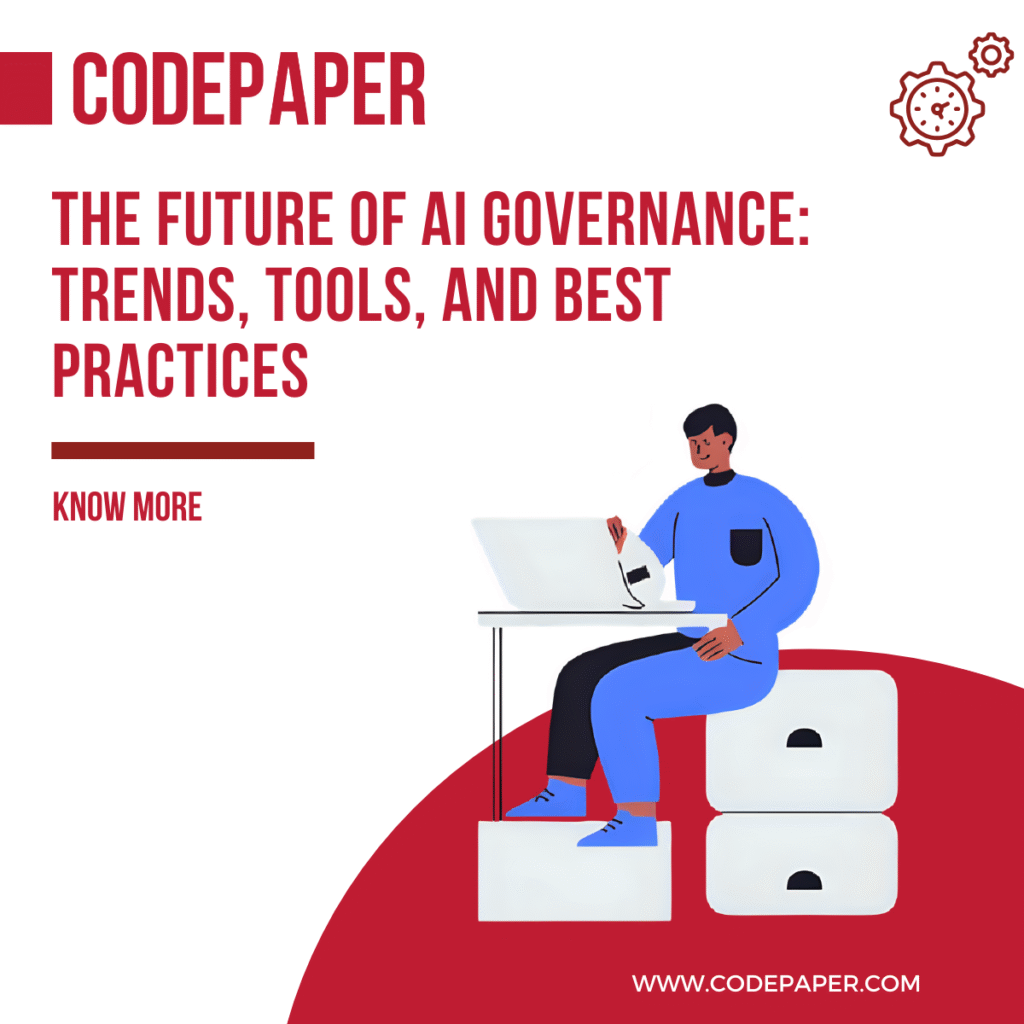Introduction: Why AI Governance Is Critical in 2025
Artificial Intelligence is no longer an experimental innovation. In 2025, AI is embedded in nearly every industry—healthcare, finance, education, e-commerce, and law enforcement. While AI systems drive productivity and innovation, they also raise serious concerns around bias, explainability, transparency, and compliance.
This is where AI governance comes in. It refers to the policies, frameworks, and tools that ensure AI systems are fair, secure, ethical, and compliant.
This blog will explore:
- What’s causing the AI governance gap
- Emerging tools & frameworks for AI governance
- Real-world best practices
- How organizations can prepare now

The Problem: The Growing Gap in AI Governance
Many companies are racing to adopt AI but overlook the AI governance frameworks needed to manage risk. This leads to problems like:
- Lack of transparency in algorithmic decisions
- Inadvertent bias in models
- Mishandling of personal data
- Limited accountability in automated outcomes
Without responsible AI governance, organizations face reputational damage, regulatory penalties, and loss of stakeholder trust. To implement secure and transparent AI systems, explore our AI consulting services designed for enterprise-level governance.
The Impact: What Happens When AI Governance Is Missing
Real-world consequences are already visible:
- Amazon’s AI recruiting tool showed gender bias
- Facial recognition systems misidentified people of color
- Healthcare AI tools made flawed clinical recommendations
- Credit risk models denied loans with no explainability
As AI becomes ubiquitous, these risks multiply—particularly in regulated industries like finance, healthcare, and legal systems. If you’re building custom AI tools, our custom software development company in Canada ensures compliance-first development.
The Solution: A Future-Proof AI Governance Framework
Let’s explore the five essential pillars of a robust governance plan for 2025:
1. Key Trends Shaping AI Governance in 2025
Rise of Global Regulations
- EU AI Act: Imposes classification of risk levels and mandates transparency for high-risk systems.
- U.S. Algorithmic Accountability Act: Requires bias audits and data protection.
- China’s Generative AI Rules: Sets limits on content and ethics.
Enterprise-Level AI Governance Models
- AI Ethics Boards
- Governance-as-Code
- AI Risk Management Systems
Shift Toward Ethical AI Principles
- Fairness
- Transparency
- Explainability
- Non-Discrimination
2. Core Elements of AI Governance Frameworks
A solid AI governance strategy includes:
Policy & Ethical Oversight
- Clear guidelines on ethical AI usage
- Senior leadership accountability
- Risk-based AI project approvals
Data Governance
- Consent-driven data collection
- Bias mitigation protocols
- Robust data security practices
Model Governance
- Transparent model lifecycle tracking
- Version control and reproducibility
- Explainability of model decisions
The EU AI Act provides an evolving framework for classifying and governing AI systems in Europe. You should align your models accordingly.
3. Tools That Support Responsible AI Governance
In 2025, several tools can help automate governance:
Explainability & Fairness Tools
- SHAP & LIME – Explain model predictions
- IBM AI Fairness 360 – Detect and reduce bias
- AI Explainability 360 – Interpret opaque models
Policy Enforcement & Monitoring
- Credo AI – Scorecards for compliance tracking
- Fiddler – Monitor model behavior and drift
- Monitaur – Real-time audits, logs, explainability
Bias Detection & Reporting
- Fairlearn Dashboards
- Custom real-time compliance alerts
- Auto-generated AI audit reports
4. Best Practices for Implementing AI Governance
Successful implementation requires:
Cross-Functional Teams
Include:
- Data scientists
- Legal & compliance officers
- DEI representatives
- External ethicists
Create an AI Governance Charter
Define:
- Ethical goals
- Risk appetite
- KPIs and audit schedules
Ongoing Training
- Internal compliance training
- Certification programs (e.g., CPRA, GDPR, EU AI Act)
Tools like Credo AI help you audit your models for fairness, accountability, and compliance.
5. How to Prepare for the Future of AI Governance
Conduct a Governance Gap Assessment
Map your current AI use cases and assess their risk.
Align with Emerging Standards
Monitor:
- Changes in EU AI Act
- Algorithmic Accountability Act updates
- National AI liability laws
Prepare for Stakeholder Scrutiny
Transparency is key. Publish responsible AI commitments and processes. Need expert resources to support ethical AI projects? Check out our staff augmentation services for vetted AI talent.

Real-World Examples of AI Governance in Action
Microsoft’s AETHER Committee
Their AETHER board reviews AI use cases across legal, engineering, and ethical dimensions.
Google DeepMind
Established a multidisciplinary AI ethics board (though criticized for lack of transparency).
Salesforce
Built an Office of Ethical and Humane Use to align AI projects with inclusive values. For compliant, scalable web applications, our Laravel development team integrates governance best practices.
Conclusion: Responsible AI Begins with Governance
By 2025, AI governance is not optional—it’s mission-critical. Without the right policies, tools, and teams, even the best AI can go dangerously off-track.
To build public trust, ensure compliance, and unlock sustainable innovation, governance must be built into the development pipeline—not bolted on later.
Ready to Govern AI Responsibly?
Explore our AI Governance Consulting Services and get a free compliance audit today.
FAQs – AI Governance in 2025
What is AI governance?
AI governance refers to the rules, processes, and tools that ensure your AI systems are used responsibly, ethically, and legally.
What should an AI governance framework include?
It includes:
- Clear ethical policies
- Bias-free data handling
- Explainable models
- Continuous auditing
- Multi-stakeholder oversight
What tools help enforce AI governance?
Use tools like:
- Credo AI for governance scorecards
- SHAP for model explainability
- Fiddler AI for real-time monitoring
Is AI governance legally required in 2025?
Yes. The EU AI Act, GDPR, and U.S. laws increasingly require proof of AI oversight and fairness in high-risk systems.
How do I start implementing AI governance?
Start with:
Real-time monitoring tools
A governance gap analysis
Cross-functional teams
Ethical guidelines
